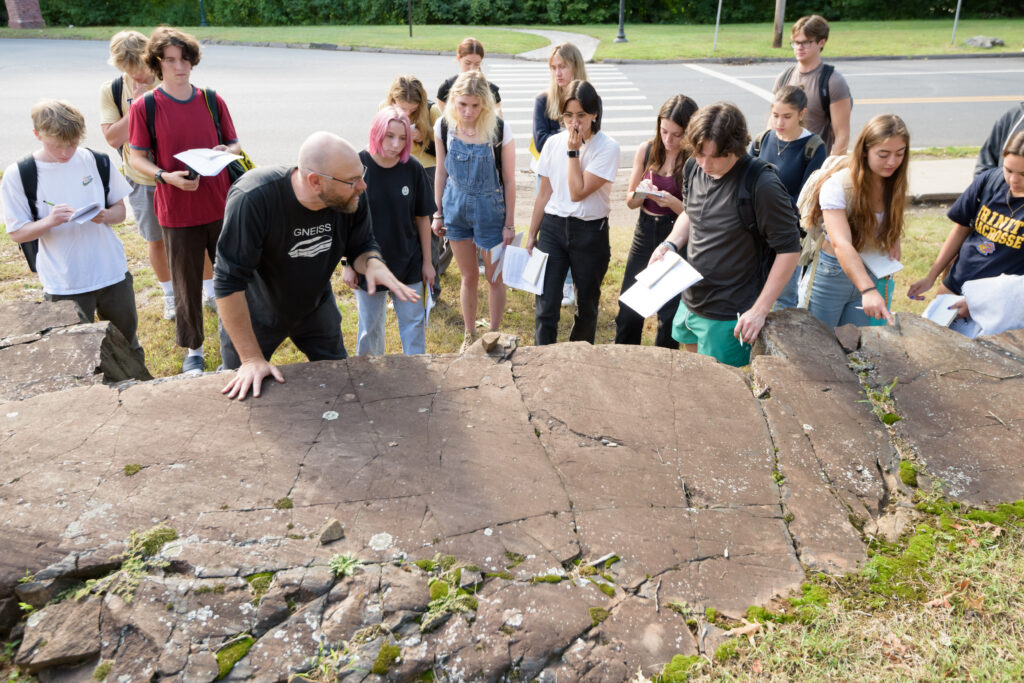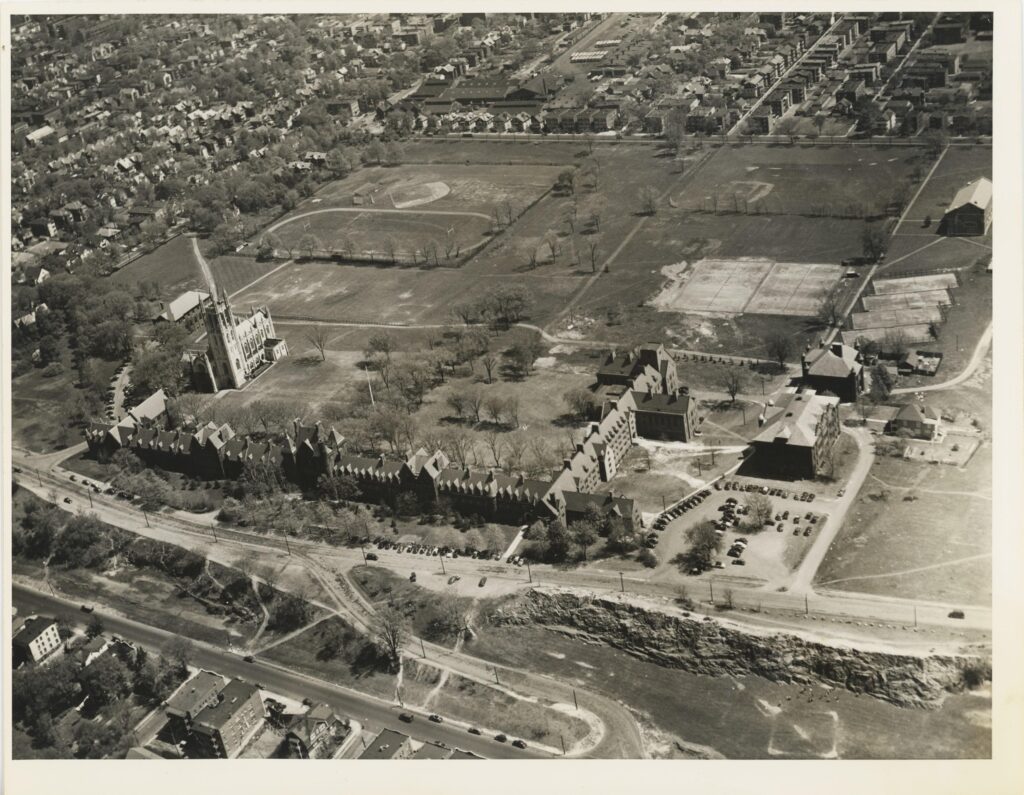Etched in stone
Geology of campus affected planning, development
By Eliott Grover
As Trinity College continues to mark its Bicentennial, the Reporter dug deep—figuratively—into the geological foundation of the campus on Summit Street. Read on to learn what we unearthed about the background of what was once known as Rocky Ridge.
Back to the Beginning
According to 300 Million Years of Trinity History: A Field Trip into the Geology of Trinity’s Campus, a pamphlet by Christoph E. Geiss, professor of physics and environmental science, and Jonathan Gourley, principal lecturer and laboratory coordinator in Trinity’s Environmental Science Program, the rocks underlying Trinity’s campus were created some 200 million years ago during the Jurassic Period and the breakup of Pangea, the supercontinent that had formed roughly 100 million years earlier.
Rifting, the pulling apart of tectonic plates, shaped a series of parallel valleys between Africa and the Americas. Water flowed into these valleys, creating a narrow inland sea between the conjoined continents. As the rifts widened, many of the valleys joined a larger system that became the Atlantic Ocean. But the Hartford Basin, the rift that opened in the Connecticut Valley, never fully developed. As geologic time passed, volcanic and glacial activity took turns shaping the Hartford landscape.
Geiss says that as the Hartford Basin opened, it dumped red sediment into the valley below. Over time, thanks to the mineral-rich groundwater that seeped up, the sediment compacted, cemented, and turned into sedimentary bedrock. Meanwhile, the widening rift created long cracks in the Earth’s surface. Through those cracks, magma rose to the surface and then formed big lava flows. Geiss says the lava cooled in a horizontal position and turned into the basalt rock upon which Trinity is built.
“If you go down to Zion Street, to that little park down there, you can see the base of that basalt flow,” Geiss continues. “The base was deposited as the basalt overran the red sediment. Those sediments had water in them, and the water evaporated on contact. You can actually see little gas bubbles in the basalt that came when the water evaporated out of the sediments, trying to squeeze their way into the basalt, and then froze in place.”

PHOTO: NICK CAITO
Also as the Hartford Basin opened, it stretched asymmetrically, creating the ridge that Trinity is sited on, Gourley says. “The ridge is there because all those rocks slowly but surely tilted to the east, allowing them to extend upward toward the west.”
Like much of the Northeast, Trinity’s campus bears the scars of glacial activity and erosion. “The rocks tell a story of the past,” he continues. “Boulders as big as school buses were getting dragged along the base of this continental glacier and scraping the bedrock.” Glacial striations, such as the ones visible near the Fuller Arch, he says, point north to south and indicate which way the glaciers were moving.
Building the Buildings
After the 1872 sale of the College’s original campus to the City of Hartford as the site for the new State Capitol, Trinity’s trustees purchased a large parcel about a mile to the southwest. The new campus, Rocky Ridge, was perched atop a cliff whose face had been chiseled by a defunct quarry that fed the city’s industrialization. That cliff formed the western edge of the long ridge that ran north to south between the Farmington and Connecticut River Valleys.
“The majesty of Trinity and the landscape that you can see off to the east is 100 percent controlled by the bedrock geology. . . . To maximize that wonderful view, the architects of Trinity College built a series of buildings and quadrangles that looked out to the east,” Gourley says. “Not that the west wasn’t attractive as well, but it’s a cliff off to the west side. That makes for a difficult campus if you extend down a cliff side. But if you extend down this nicely, gently sloping east-tipping landscape, it really allows the architecture to build a gorgeous campus, which we have.”
Alden Gordon ’69, Paul E. Raether Distinguished Professor of Fine Arts, notes that in the 1870s, Trinity trustees hired acclaimed British architect William Burges to design the Rocky Ridge campus. A leading figure in the Gothic Revival movement, Burges was based in London and never actually visited Hartford; he trained an American architect named Francis Kimball to serve as his lieutenant. “Kimball was the one who saw the importance of cooperating with the north-south axis that was given by the geological formation,” says Gordon.
Kimball also discerned that Burges’s initial plan, which called for four ornate quadrangles, was too costly, Gordon says. Kimball suggested a single linear building known as a “bar building” that could run parallel to the ridge. Burges used this recommendation to design the Long Walk, the continuous structure that defines Trinity’s campus and has influenced many others across the country.
“It’s an earlier and more authentic Gothic Revival than most other New England campuses,” says Gordon. “The Gothic at Yale and Wellesley is all 20th century. Trinity being in the 1870s was in the first wave of American campus buildings that was looking to the European style.”

With the cliff forming Trinity’s western boundary, Gordon explains, Burges and Kimball used rubble from the Long Walk excavation to level the ground for the Main Quad on the east. Overlooking a pastoral New England landscape that rolled gently toward the Connecticut River, the view from the quad became a focal point of future campus planning.
For the 1923 Centennial, the trustees hired the architecture firm Trowbridge & Livingston to create the College’s second master plan. Samuel Trowbridge was a Trinity graduate, Class of 1883, and his design led to many significant buildings, including Cook Hall, Hamlin Hall, and the Trinity College Chapel. A critical element of the Trowbridge plan was that it honored Burges and Kimball’s respect for the site’s topography.
“Trowbridge and Livingston were smart enough to understand that they could square off the corners of the Burges bar building and make a return, but they would never close the eastern view,” says Gordon. “That’s what makes Trinity distinctive. The Main Quad is, in fact, not a quad. It’s an open U.”
Gordon says that the U-shape almost disappeared as part of Trinity’s third master plan in 1996. “There was this fully developed plan to add to the library and have it come out to the statue of the Bishop,” he says, adding that the proposed expansion would have closed off a quarter of the Main Quad’s eastern view. Gordon was part of a coalition that lobbied successfully for the College to build the library addition in the opposite direction. “The first exercise in that master plan,” he jokes, “was to stop a building from being built.”
Today, the Raether Library and Information Technology Center offers an ideal vantage point to visualize the area’s geologic history. Gourley says he likes to visit the building’s rooftop for a panoramic view of the landscape. “You can see the big picture,” he says. “You see all the way across to the eastern side of the valley where the Connecticut highlands start and where the rifting ended because there’s a big fault there.”
Voice from Yesteryear
Writing in 1923, Trinity President Remsen Ogilby acknowledged the disparate relationship between biological and geological events. “The College itself proudly records a single century, while the rocks below register in silence thousands and millions of years.” Ogilby seemed to understand that a milestone anniversary was the perfect opportunity to recognize the history of the College and the land beneath it. Today, 100 years later, the Bicentennial offers a similar occasion to celebrate Trinity’s past and its commitment to the future, an ever-evolving story etched in scholarship and stone.
Time after time
The geologic timescale might be considered a dizzying concept. One tip from the National Park Service is to imagine geologic time as a calendar year. If Earth formed on January 1, 4.6 billion years ago, dinosaurs did not become dominant until December 15. The dinosaurs were extinct by December 19, and the Pleistocene ice ages lasted for about three hours on the morning of December 31. Humans first appeared at 11:38 p.m. on New Year’s Eve.
What is your favorite place on campus?
Tim Lenicheck ’63
I visited Trinity during spring vacation of my junior year in high school because the dean at the Episcopal Cathedral in Milwaukee, my home church, asked me to stop by and say hello to his friend from seminary days, Mo Thomas, who was chaplain at Trinity. He pointed out that I would be going to Harvard from Princeton and this would be a good break from the highway. So, I did. Reverend Thomas was not on campus—(almost) nobody was since it was spring break—but someone in Admissions produced a student who was on campus writing a senior paper, and he walked around with me. The day was classic pre-spring: bare branches, gray sky, chilling wind, almost funereal. Not at all like the warm sunny day I’d had at Princeton. The Long Walk, anchored then and now by the Chapel at one end and the library at the other, sent me a clear message: this was a place where I could learn—academics, yes, but much more. I saw Harvard—arrogant, aloof, needing nothing and certainly not me. When I was told Princeton grads loved it so much they were buried in orange-and-black blazers, my mind was made up: I was going to Trinity if it would have me. It would, and the rest is history. Meaningful places on campus? The Chapel and the Long Walk, of course. I lived three of my four years in Jarvis and Cook. Sometimes you get lucky. I did.
Bob Ebinger ’67
My favorite building on campus was the newly built Austin Arts Center. It was here I developed my love for theater as a member of the Jesters. Not adept at acting, I enjoyed being behind the curtain once as the stage manager for Rhinoceros. In one of the center’s rooms, I started the Film Society using Arthur Knight’s The Liveliest Art and viewing 16-millimeter films from The Museum of Modern Art film library. Several of my fellow cinephiles went on to found Cinestudio in the old Clement Chemistry Building, which at my time was a lecture hall for my first-year history lectures. What were the two windows in the above room? several of us wondered. Not until James Hanley discovered that it was a projection room with its aging projectors was the Cinestudio idea born.
Ian Y. Bennett ’62
My favorite place at Trinity was the football field. I was with classmates who share my love of that game.
Scott Cassie ’82
My favorite place was, and still is, the Funston Courtyard. This oasis of green calm is nestled between Clement Chemistry Building and the library. The steps with the then-working fountain leading up to the quad and library entrance were the favorite path from my freshman room in Jones Hall.
The Clement building’s first-floor windows of my freshman chemistry course with Dr. Henry DePhillips looked out onto this beautiful gem. I remember looking out those windows as the seasons changed. New England autumn color gave way to silent snowfall, and then dogwood blossoms announced spring. That view would always generate within me a relaxing joy and a smile in the midst of navigating the rest of my hectic freshman year.
Therefore, when our 40th Reunion Dinner was scheduled to be held in the Funston Courtyard, I felt that it was channeling my personal Trinity karma. We enjoyed a great night in this intimate outdoor space. That relaxing joy and smile returned to me, these many years later.
Read more personal reflections on the Bicentennial website at www.trincoll.edu/Bicentennial/200-Stories.
